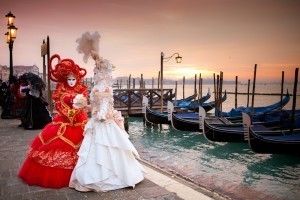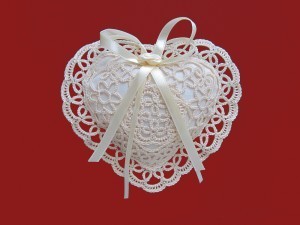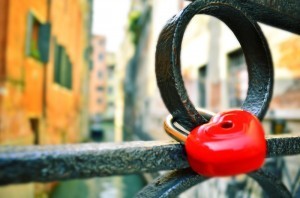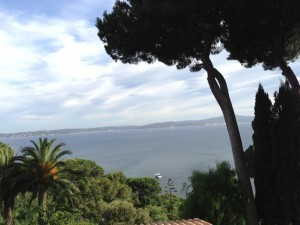Hannah Fielding's Blog, page 110
February 14, 2014
Top ten romantic things to do this Valentine’s Day, inspired by Venice, city of love
It’s here again, the best day of the year for any romantic like me: Valentine’s Day! A day for casting off all vestiges of the sensible and mundane, and embracing high romance.
If I ask you to close your eyes and imagine the most perfect Valentine’s Day date, what do you see? I see Venice, Italy – setting for my new romance novel, The Echoes of Love. Whenever I visit Venice, I am swept away by the romance of the location. With that in mind, today I’m sharing ten ideas for Valentine’s Day dates inspired by my own experiences in Venice, so that even if you can’t be in ‘the city of love’ today, you can create for yourself the essence of the place:
Take a boat ride. Your local boating lake or river may not offer all the romance of a gondola ride, but taking to the water as a couple is an opportunity for alone time. Whether you’re drifting gently and gazing dreamily into each other’s eyes, or laughing uproariously as you attempt to navigate the craft, you’re bound to share a special moment.
Admire a view. Venice is a city of stunning historic architecture where eyes are always drawn to the panorama. Take inspiration from the quest of the tourist to find the best spot for a photo to impress those back home – in your local area, seek out The View. Climb a hill. Drive to the seaside. Book a restaurant table by the window. Take a walk at sunset and kiss your sweetheart beneath a sky awash with colour.
Go shopping for romantic gifts. No, not to your nearest mall, but to a quaint spot where you can rummage in little independent shops, looking at antiques and bric a brac and artisan-created wares. Set a challenge that each must choose for the other a gift to symbolise the relationship – it’s all the more fun if you set a small budget, forcing you to think imaginatively.
Visit an art gallery. Venice is a world-renowned centre of art, and visitors have a wide choice of galleries to explore. Where can you go locally that will similarly transport you and inspire you? If you can, choose a gallery with a café that serves good coffee and cakes!
Go to the theatre. Whatever fires you up – a romantic ballet, a stirring opera, a lively musical, a concert by your favourite artist – book tickets and then make an occasion of the event. Have pre-show drinks. Buy a programme to keep as a souvenir. Book a box, if available! Make it a night to remember, and then afterwards, buy the CD of the music so every time you play it you can remember your romantic evening.
Sip a Bellini. Did you know that this light cocktail, comprising Prosecco sparkling wine and peach purée, originated in Venice? It was created by Giuseppe Cipriani, founder of Harry’s Bar, which since its opening in 1931 has counted among its patrons Ernest Hemingway, Charlie Chaplin, Alfred Hitchcock, Truman Capote, Orson Welles, Baron Philippe de Rothschild, Princess Aspasia of Greece, Peggy Guggenheim and Woody Allen. So head to your nearest cocktail bar and indulge like the rich and famous!
Enjoy a leisurely meal. Forget a single course, eaten quickly. Make an occasion of your Valentine’s meal, whether you’re eating at home or in a restaurant. And, of course, choose Italian as the cuisine!
Masquerade. Mystique, allure, glamour: masks and costumes are quintessentially romantic! Venice is famous for its unique masks and costumes, which will be out in force from tomorrow onwards in the city as the famous Carnival commences. If no masquerade ball is to be held in your locality, why not introduce a little dressing up at home…
Dress to impress. Take a leaf from the Italians’ book and make appearance matter for just this day. Have a pamper – a bath, a manicure. Put on makeup, do your hair, spritz your favourite scent. Choose clothes that make you feel beautiful. Watch your partner’s eyes light up as you arrive at the date!
Leave a mark of your love. The picturesque Rialto bridge in Venice is just one of several tourist attractions in Italy at which lovers have left padlocks to symbolise their love. Think beyond obscuring a beautiful location with a metal lock, however. Carve your initials into a tree, or a Chinese paper lantern that you release into the air. Write your love large on a wall in your home, and then paper over it so that a future generation will one day find it. Pen each other a love letter. Do whatever is meaningful for you and will stand the test of time.
February 13, 2014
The Virgin in black
February 12, 2014
Publishing lessons today’s women writers can learn from yesterday’s
 Lest we modern writers forget, there was a time when female writers faced a good deal of prejudice when it came to being taken seriously as authors and poets. When Charlotte Brontë sent some of her poems to the then poet laureate Robert Southey, for example, he wrote back: ‘Literature cannot be the business of a woman’s life, and it ought not to be. The more she is engaged in her proper duties, the less leisure will she have for it, even as an accomplishment and a recreation.’
Lest we modern writers forget, there was a time when female writers faced a good deal of prejudice when it came to being taken seriously as authors and poets. When Charlotte Brontë sent some of her poems to the then poet laureate Robert Southey, for example, he wrote back: ‘Literature cannot be the business of a woman’s life, and it ought not to be. The more she is engaged in her proper duties, the less leisure will she have for it, even as an accomplishment and a recreation.’
In its winter 2013 edition, The Author magazine published an article entitled ‘Old ways for publishing to be different: Jane Austen in the literary marketplace’, written by EJ Clery, professor of 18th-century literature at Southampton University, which outlines Jane Austen’s path to publication. I found the article fascinating and inspiring for its realistic appraisal of just how hard Austen had to work for her success. It fired me up to think about other classic writers and how their journeys from concept to print may inspire modern writers. Today, then, I’m sharing lessons we can take from the publication stories of great women who, in a male-dominated sphere, had to fight to have their words read.
1. Take risks
As the Author article explains, after twelve years of trying to get published, Austen took the unusual route of publishing Sense and Sensibility ‘on commission’, which meant, essentially, that she paid a commission to the publisher for it to publish her work (royalties in reverse) and she agreed to cover any losses, risking a total of £180 on the endeavour. Happily, her speculation paid off, and she made a good profit.
2. Put aside the ego
No doubt Emily, Charlotte and Anne Brontë wished the world would respect their literary works, and they eventually did – but not, initially, with full knowledge of their authorship. For their first publication, Emily, Charlotte and Anne Brontë created a joint work of poems, found a publisher and put out the book under the masculine pseudonyms of Currer, Ellis and Acton Bell. They knew that the market wouldn’t take seriously the books were they published under female names, so they conformed to expectations. They put first the work, not their desire for personal recognition. So, too, did Mary Shelley – the first edition of her ground-breaking novel Frankenstein was published anonymously.
3. Write not to be published, but for yourself
Poet Emily Dickinson is today one of the world’s most respected and read female poets. In her lifetime, though, she knew scant publication success, seeing only a handful of her works in print – in part due to who she was, an introverted and reclusive lady; in part for the unique, unconventional nature of her writing which went largely unrecognised as genius in her time. That did not deter her, however, from writing, writing, writing: she was hugely prolific, penning close to 1,800 poems.
4. Write what is in your heart to write, no matter the consequences
When Abraham Lincoln met Harriet Beecher Stowe during the American Civil War, he reportedly said: ‘So you’re the little woman who wrote the book that made this great war!’ The book to which he was referring is, of course, Uncle Tom’s Cabin, whose anti-slavery message was widely influential when the book was published. Abolitionist Beecher Stowe had written, ‘I feel now that the time is come when even a woman or a child who can speak a word for freedom and humanity is bound to speak… I hope every woman who can write will not be silent.’ She was a courageous woman indeed for speaking out on such a subject.
February 11, 2014
St Mark’s Basilica and the history of mosaics
 My heroine in The Echoes of Love, Venetia, is by profession a professional restorer of mosaics, a job requiring a great deal of skill, care and knowledge. She is well placed to carry out her work, located as she is in Venice, which played a key part in the history of the mosaic.
My heroine in The Echoes of Love, Venetia, is by profession a professional restorer of mosaics, a job requiring a great deal of skill, care and knowledge. She is well placed to carry out her work, located as she is in Venice, which played a key part in the history of the mosaic.
The earliest mosaics discovered date back some 4,000 years, just simple patterns made with pebbles, but it was the ancient Greeks who elevated the mosaic to an art form, and their work was soon taken up by the Romans. From the 5th century onwards, at the time of the rise of the Byzantine Empire, the creation in Italy of glass tesserae changed the look of the mosaic to that with which we are familiar today. The tesserae (from the Greek for ‘four-sided’) were made from large sheets of opaque, brightly coloured glass, sometimes with silver or gold leaf on the back, and were set at slight angles to reflect light around a room. Mosaics until that point had been largely set into floors, but now walls and ceilings became wide canvases for this art.
In twelfth-century Venice, Byzantine mosaics were all the rage. The Torcello Cathedral contains several stunning examples, including a huge mosaic of the Last Judgement, and St Mark’s Basilica in the city is aglitter with golden mosaics that span in total about an acre, earning the basilica the name Chiesa d’Oro, ‘Church of Gold’ (for detailed pictures, click here).
To this day, Venetian company Orsoni, which began trading back in 1888, remains one of the most prestigious producers of mosaic tiles in the world, having supplied materials for the Trocadéro and the Basilica of the Sacre Coeur in Paris, Saint Paul’s Cathedral in London and the Sagrada Familia in Barcelona. For a glimpse of some of the stunning tesserae available, visit the Orsoni website. Orsoni also offers a mosaic course for those who want to learn from the masters of the craft.
No doubt my character Venetia would have attended the Orsoni course. And I wish I could too…
A common question I am asked in author interviews is: ‘How much of yourself do you put in your characters?’ The answer is always, ‘A little, but my characters are not direct reflections of me.’ When it comes to Venetia’s career, I suppose you could say I am living vicariously. How I would love to do her job, to have studied as she has, to have visited so many of the world’s most beautiful ancient mosaics!
February 10, 2014
Italian Recipe: Gelato cioccolato all’azteca (pepper and cinnamon chocolate ice-cream)
 Gelato – soft, creamy ice-cream – is a popular dessert in Italy, and such a wonderfully wide array of flavours is available: pistachio, almond, hazelnut, egg custard, coffee, zuppa inglese, rum and raisin, even liquorice. Personally, I find the chocolate flavours calling to me, from the delicious cioccolato fondente (fondant) to the cioccolato all’arancia (orange). But when it came to choosing a dessert to incorporate in a meal shared by my hero and heroine in The Echoes of Love, I had to go with gelato cioccolato all’azteca: pepper- and cinnamon- infused chocolate ice-cream. It’s sumptuous, it’s tangy, it’s hot, it’s passionate: everything required to complete a romantic meal à deux.
Gelato – soft, creamy ice-cream – is a popular dessert in Italy, and such a wonderfully wide array of flavours is available: pistachio, almond, hazelnut, egg custard, coffee, zuppa inglese, rum and raisin, even liquorice. Personally, I find the chocolate flavours calling to me, from the delicious cioccolato fondente (fondant) to the cioccolato all’arancia (orange). But when it came to choosing a dessert to incorporate in a meal shared by my hero and heroine in The Echoes of Love, I had to go with gelato cioccolato all’azteca: pepper- and cinnamon- infused chocolate ice-cream. It’s sumptuous, it’s tangy, it’s hot, it’s passionate: everything required to complete a romantic meal à deux.
Here’s an easy recipe you can try at home:
Ingredients
1 teaspoon cinnamon
150g caster sugar
230g chilli chocolate (try Thornton’s, Green & Black’s or Lindt)
375ml crème fraîche
375ml whole milk
4 large egg yolks, whisked
pinch of salt
Place the chocolate in a large mixing bowl.
Place the milk, salt and sugar in a saucepan and warm.
Gradually whisk the milk mixture into the eggs, and return to the saucepan, heating until thickened.
Strain sauce through a sieve over the chocolate and stir until it melts.
Whisk in the cream, and then the cinnamon.
Chill in the fridge for four hours and then freeze (or transfer to ice-cream/gelato maker).
Serve with ginger cake or chocolate cake. Enjoy!
February 8, 2014
‘You shall go to the ball’: The Venice Carnival 2014
 For as long as I can remember, I have loved fairytales. I recall so vividly those told to me by my governess, Zula – the traditional tales of folklore and those she invented to suit my romantic sensibilities. One of my favourite aspects of any story was a ball: a colourful, flamboyant, lively party to form a backdrop against which the hero and the heroine would share a moment of meaning and passion. Ugly sisters and fairy godmothers and rats turned into footmen were interesting enough, but it was the ball at which Cinderella stole her prince’s heart that I would beg Zula to describe in detail, over and over; that I would close my eyes at night and travel to, picturing the dresses, the dancing, the music.
For as long as I can remember, I have loved fairytales. I recall so vividly those told to me by my governess, Zula – the traditional tales of folklore and those she invented to suit my romantic sensibilities. One of my favourite aspects of any story was a ball: a colourful, flamboyant, lively party to form a backdrop against which the hero and the heroine would share a moment of meaning and passion. Ugly sisters and fairy godmothers and rats turned into footmen were interesting enough, but it was the ball at which Cinderella stole her prince’s heart that I would beg Zula to describe in detail, over and over; that I would close my eyes at night and travel to, picturing the dresses, the dancing, the music.
Sadly, in the modern age, there is little occasion to make a little girl’s dream come true: put on finery, slip an arm through that of a handsome man and step onto the dance floor at a grand ball. But if you are fortunate enough to work as a writer, you can let your imagination take flight and place your hero and heroine at the scene. That is exactly what I did in my novel The Echoes of Love, which opens at a ball during the Venice Carnival.
Paolo and Venetia, the lovers in The Echoes of Love, may be fictional, but the ball that they attend is by no means fantasy. The 2014 Carnival commences in a matter of days, running from 15th February to 4th March, and you’ll find a whole host of balls on the events schedule: the Casanova Grand Ball, the Enchanted Palace Ball, the Saint Valentine’s Grand Ball, the Mascheranda Grand Ball, the Grand Feast of the Gods, the Thousand Nights of Arabia, the Moon Masquerade, the Grand Carnival Ball, the Baroque Grand Ball, and the Serenissima Grand Ball, to name but a few! Many are held in beautiful buildings – ancient palaces lit by candlelight – and at all guests can expect a truly cultural experience, from the décor to the menu, the music to the entertainers. Drama, passion, splendor, pageantry, and all amid the age-old, traditional masquerade costumes and masks. Magnifique!
I wish I could be there, but this year I’m busy in England with preparations for my son’s wedding, so I’m unable to attend the Carnival.
How about you? Would you love to step out at one such ball? Have you ever attended a ball? Was it a night to remember? I would love to hear about your experiences.
And if you are going to be in Venice for this year’s Carnival season, or you’d simply like to check out the calendar and the costumes, visit its official website at http://www.venice-carnival-italy.com/.
February 6, 2014
Where sky and sea collide
February 5, 2014
‘The Echoes of Love: Making the Audiobook’ – a video interview
‘The heart has its reasons which reason does not know…’
Any romance author faces a challenge in his or her writing:
The character’s journey to falling in love, from feeling the first stirrings of attraction to making a lasting commitment, must make logical sense to the reader…
But:
… love, sometimes, defies logic.
Take any enduring love story, one that captures imaginations to the extent that it becomes more than a book and part of the very fabric of a culture: Romeo and Juliet, Jane Eyre and Mr Rochester, Bella Swan and Edward Cullen, to name but a few. In each love story, the characters face turmoil and inner conflict: their love is not easy, simple, but a choice to make that involves courage and surmounting obstacles. In each story, we follow the characters’ struggle, and the draw for us is seeing them conquer all and find that happy ending. Along the path, we see the unfolding of the journey, the cognitive process that evolves as the characters work through their issues to that place of peaceful, accepting love. That is a romance story. That is what we love to read.
And yet, within all the reason laid out carefully by the author there lies a little of what Shakespeare called the ‘madness’. For as seventeenth-century French theologian Blaise Pascal so adeptly put it, ‘the heart has its reasons which reason does not know’. Love is not always rational, sensible. Love can be rash, daring, crazy, incorrigible. Romeo and Juliet committed suicide for their love. Jane Eyre ran away from Mr Rochester though she had nowhere to go. Bella and Edward, lamb and lion, fell in love though they were utterly incompatible.
In my latest novel, The Echoes of Love, I was conscious throughout the writing of striking the balance between logic and instinct, reason and that pure, heady love that comes from a place of sublime romance. This was particularly interesting for me as an author because my heroine, Venetia, is usually a cool, level-headed, pragmatic woman. An architect by profession, she is trained to be methodical and exact, and to drill down to the level of minutiae. She is a thinker, an explorer – an intellectual. So when she meets Paolo, and is instantly seized by strong feelings of attraction, she is somewhat derailed from her usual path. How does this attraction fit with logical analysis? How does the sense of destiny about their blossoming relationship marry up with a way of life that has for so many years been calm, controlled, controllable?
The result is a woman plunged into confusion, doing her best to find the right path through her myriad feelings and thoughts. And by the ending of the book (whose twist I wouldn’t dream of giving away here!) some of the reasons of the heart ‘which reason does not know’ become a little clearer.
Ultimately, though, I believe that in any romance story an element of ‘je ne said quoi’ must remain. Isn’t that what makes falling in love, being in love, so full of wonder and sensation? In what other part of life do we get the sheer pleasure, the freedom and thrill, of moving away from obeying the head, too often cold and rigid, and surrendering unequivocally to the heart, warm, vivacious, affirming?
What do you think? Do you embrace ‘the heart has its reasons which reason does not know’? Or do you like to trace a clear logic for two people to be together? To what extent does romance mean sacrificing reason? I would love to hear your thoughts.
February 4, 2014
Another Venetian treasure: Burano lace
 My latest novel, The Echoes of Love, opens at the time of the Venice Carnival – a lively, historical event that heralds parties galore and plenty of opportunities to dress up. The protagonist, Venetia, attends a grand masquerade ball, at which both men and women wear traditional Carnival costumes:
My latest novel, The Echoes of Love, opens at the time of the Venice Carnival – a lively, historical event that heralds parties galore and plenty of opportunities to dress up. The protagonist, Venetia, attends a grand masquerade ball, at which both men and women wear traditional Carnival costumes:
The long room, flooded with a golden glow from enormous Murano chandeliers, was filled with people mostly hidden behind carnival masks, their disguises rich and colourful, glittering with the splendour of diamonds, rubies, sapphires and emeralds. Transformed by their costumes into stately drifting mountains of Burano lace, with bright trailing peacock skirts of old brocade, the ladies flicked fans before their faceless faces, their heads adorned with neat, small cockaded tricorne.
Are you familiar with Burano lace? I had to include it in the ladies’ costumery because it is quintessentially Venetian.
Burano lace comes from the lagoon Burano island, where it has been made since the sixteenth century. Two techniques exist: punto in aria, which is created simply with a needle and thread (no fabric at all!), and tombolo, which uses a stuffed cushion as a base.
Such was the fine workmanship and delicacy of Burano lace that it quickly became popular worldwide and was bought up by nobles and royal families. Austrian Emperor Joseph II, for example, bought Venetian lace to adorn his wedding bed for 3,000 florins, and Leonardo da Vinci bought an alter cloth made of lace for the Duomo di Milano. Eventually, a lace-making industry grew on the island which contributed, along with Murano glass, significantly to the city’s wealth. In time a school was established to teach the various stitches and techniques.
The industrial revolution created machine-made lace, and thus the popularity of handmade, expensive lace dwindled. But in recent years Burano lace has been enjoying a renaissance, thanks in part to its recognition as a fine artisan creation, an artwork of sorts: after all, the lacework is very intricate, a true labour of love. In the Venetian calendar events and fairs are dedicated to promoting the historic needlework, and both on Burano and in Venice itself you’ll find shops selling artisan creations, from dresses and handkerchiefs to tablecloths and veils. If you visit Burano, be sure to take a look at the lace museum (Museo del Merletto di Burano), which has original lace dating back hundreds of years.








